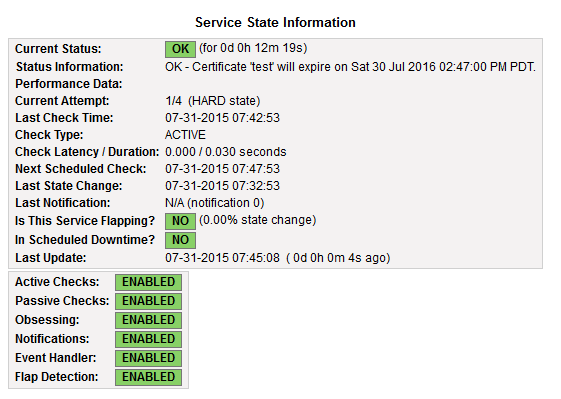前準備
- 自己認証局
- ssl証明書の作成(今回はオレオレ証明書)
- SSLの有効化(httpd)
自己認証局とオレオレ証明書の発行(参考リンク先をなぞってるだけ)
# yum install -y openssl mod_ssl
# openssl req -new -x509 -keyout ca.key -out ca.crt -days 30 -sha256
Generating a 2048 bit RSA private key
.........................+++
....................................................+++
writing new private key to 'ca.key'
Enter PEM pass phrase:
Verifying - Enter PEM pass phrase:
-----
You are about to be asked to enter information that will be incorporated
into your certificate request.
What you are about to enter is what is called a Distinguished Name or a DN.
There are quite a few fields but you can leave some blank
For some fields there will be a default value,
If you enter '.', the field will be left blank.
-----
Country Name (2 letter code) [XX]:JP
State or Province Name (full name) []:Osaka
Locality Name (eg, city) [Default City]:Osaka
Organization Name (eg, company) [Default Company Ltd]:Test.co.,Ltd
Organizational Unit Name (eg, section) []:
Common Name (eg, your name or your server's hostname) []:CA mine
Email Address []:
# cd /etc/pki/tls/private/
# openssl genrsa -out site.key 2048
Generating RSA private key, 2048 bit long modulus
.......+++
........................................+++
e is 65537 (0x10001)
# cd /etc/pki/certs/
# openssl req -new -sha256 -key /etc/pki/tls/private/site.key -out oreore.csr
You are about to be asked to enter information that will be incorporated
into your certificate request.
What you are about to enter is what is called a Distinguished Name or a DN.
There are quite a few fields but you can leave some blank
For some fields there will be a default value,
If you enter '.', the field will be left blank.
-----
Country Name (2 letter code) [XX]:JP
State or Province Name (full name) []:Osaka
Locality Name (eg, city) [Default City]:Osaka
Organization Name (eg, company) [Default Company Ltd]:Test.co.,Ltd
Organizational Unit Name (eg, section) []:
Common Name (eg, your name or your server's hostname) []:www.ore.jp
Email Address []:
Please enter the following 'extra' attributes
to be sent with your certificate request
A challenge password []:
An optional company name []:
;;===== ファイルが存在しない場合にやる
# touch /etc/pki/CA/index.txt
# echo '1000' > /etc/pki/CA/serial
;;==== ファイルが有る場合はやらない
# openssl ca -md sha256 -cert /etc/pki/CA/certs/ca.crt -keyfile /etc/pki/CA/certs/ca.key -out oreore.crt -infiles oreore.csr
Using configuration from /etc/pki/tls/openssl.cnf
Enter pass phrase for /etc/pki/CA/certs/ca.key:
Check that the request matches the signature
Signature ok
Certificate Details:
Serial Number: 4096 (0x1000)
Validity
Not Before: Jul 31 13:47:06 2015 GMT
Not After : Jul 30 13:47:06 2016 GMT
Subject:
countryName = JP
stateOrProvinceName = Osaka
organizationName = Test.co.,Ltd
commonName = test
X509v3 extensions:
X509v3 Basic Constraints:
CA:FALSE
Netscape Comment:
OpenSSL Generated Certificate
X509v3 Subject Key Identifier:
4A:BB:05:F5:DA:1A:57:B7:BE:78:88:0A:84:37:35:BD:55:01:54:93
X509v3 Authority Key Identifier:
keyid:11:D5:6A:6B:BC:BB:CF:01:71:38:00:57:E6:36:38:D1:BF:9A:2F:B5
Certificate is to be certified until Jul 30 13:47:06 2016 GMT (365 days)
Sign the certificate? [y/n]:y
1 out of 1 certificate requests certified, commit? [y/n]y
Write out database with 1 new entries
Data Base Updated
httpd側の設定
- /etc/httpd/conf.d/ssl.conf
# Server Certificate:
# Point SSLCertificateFile at a PEM encoded certificate. If
# the certificate is encrypted, then you will be prompted for a
# pass phrase. Note that a kill -HUP will prompt again. A new
# certificate can be generated using the genkey(1) command.
# SSLCertificateFile /etc/pki/tls/certs/localhost.crt ; ココを
SSLCertificateFile /etc/pki/tls/certs/oreore.crt ; こうする
# Server Private Key:
# If the key is not combined with the certificate, use this
# directive to point at the key file. Keep in mind that if
# you've both a RSA and a DSA private key you can configure
# both in parallel (to also allow the use of DSA ciphers, etc.)
# SSLCertificateKeyFile /etc/pki/tls/private/localhost.key ; ココを
SSLCertificateKeyFile /etc/pki/tls/private/site.key ; こうする
- httpdの再起動
# /etc/init.d/httpd restart
Nagiosの監視設定
- 使うもの
- check_http
Usage:
check_http -H <vhost> | -I <IP-address> [-u <uri>] [-p <port>]
[-J <client certificate file>] [-K <private key>]
[-w <warn time>] [-c <critical time>] [-t <timeout>] [-L] [-E] [-a auth]
[-b proxy_auth] [-f <ok|warning|critcal|follow|sticky|stickyport>]
[-e <expect>] [-d string] [-s string] [-l] [-r <regex> | -R <case-insensitive regex>]
[-P string] [-m <min_pg_size>:<max_pg_size>] [-4|-6] [-N] [-M <age>]
[-A string] [-k string] [-S <version>] [--sni] [-C <warn_age>[,<crit_age>]]
[-T <content-type>] [-j method]
ex) check_http -I 192.168.1.1 -C 30,15
-> 192.168.1.1の証明書の有効期限が
> 30 : OK
>= 15 : WARNING
< 15 : CRITICAL
- command.cfg
# 'check_ssl_expire_time' command definition by 'check_http' command used.
define command {
command_name check_ssl_expire_time
command_line $USER1$/check_http -I $HOSTADDRESS$ -C $ARG1$
}
- locahost.cfg(実際の監視対象)
### ssl expire check ###
define service {
use local-service
host_name localhost
service_description ssl expires
check_command check_ssl_expire_time!30,15
}
